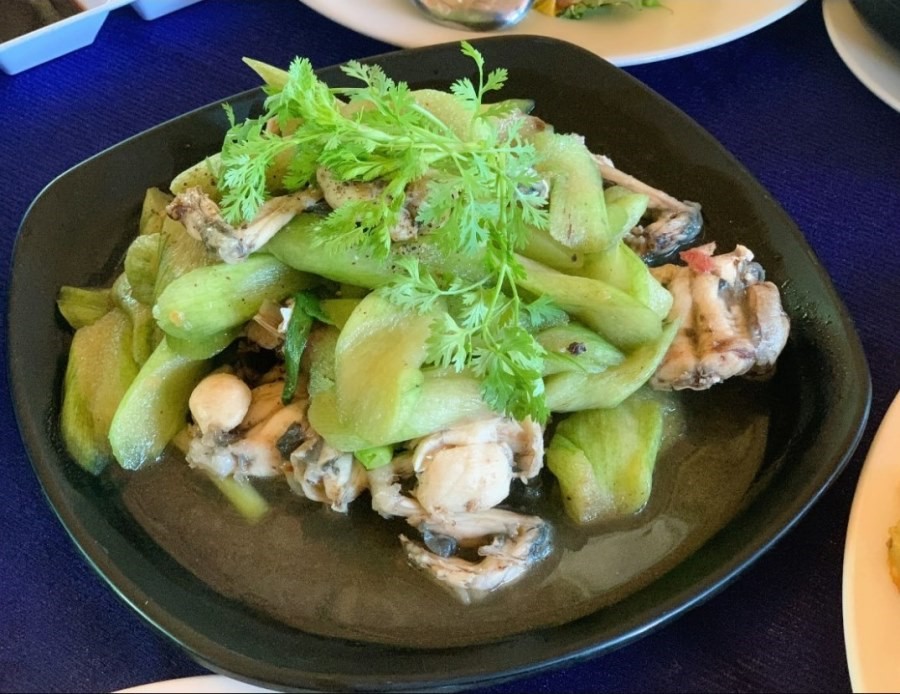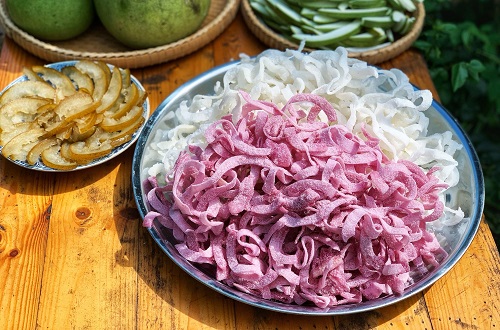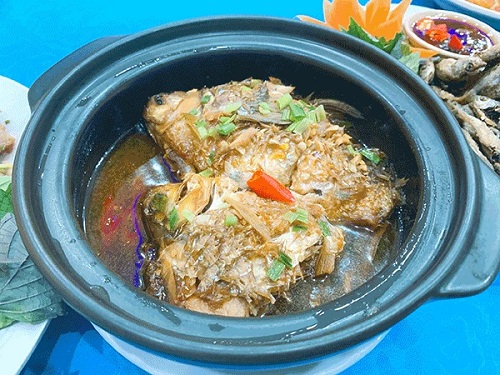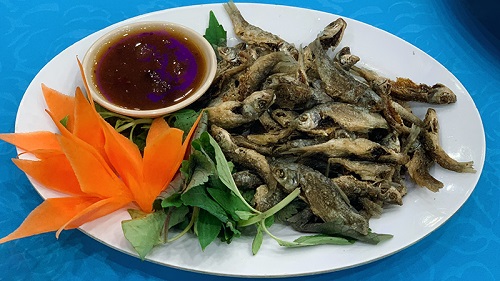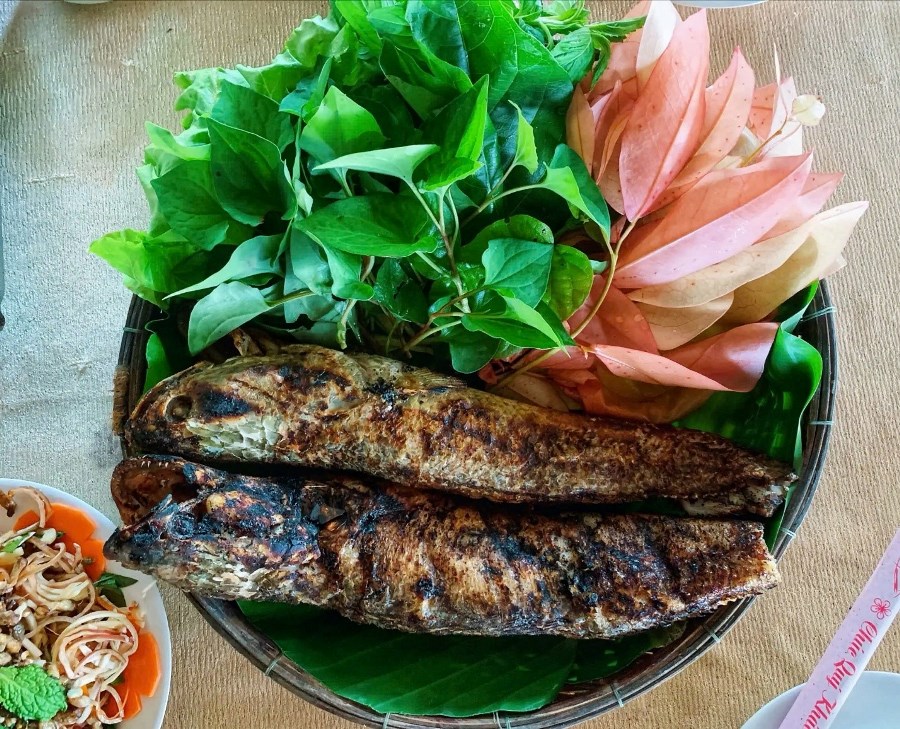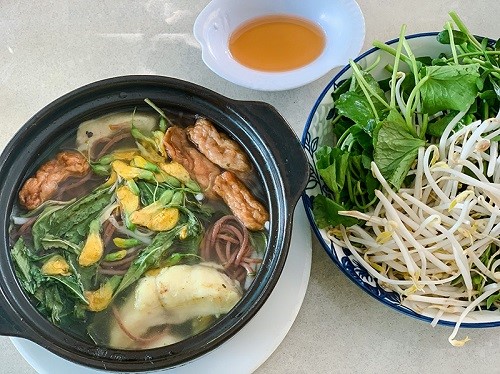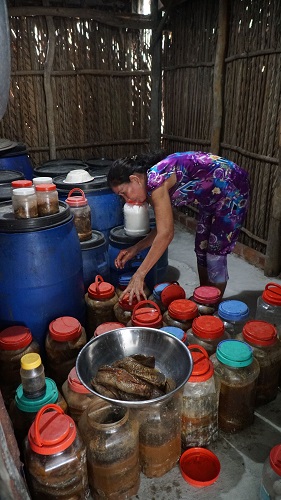
Mam and mangrove apple
“Want to eat Mam with sour mangrove apple?
Waiting for the flood season to fully eat"
Sour mangrove apple eating with raw Mam is a rustic dish but it is a "memorable" dish for those who have tried it. Lord Nguyen Anh, during his journey to the South, was also impressed by this dish.
Story has it that during his escape from the Tay Son dynasty, Lord Nguyen Anh and his entourage arrived at the Ham Luong gate via the Ba Tri route. They traveled at night and got lost, and their boat ended up in Ba La and Ca Mit (now part of Ben Tre province). Here, Nguyen Anh met a wealthy local man who warmly welcomed him. When Nguyen Anh expressed his desire to eat a simple dish, without having to trouble his entourage and not exposing the mission, the chief named Hac went to the kitchen, scooped out some raw Mam from a jar, and went to the field to pick some thinly sliced sour mangrove apple to eat with it. Nguyen Anh found it extremely delicious and asked for the name of the fruit. When he found out it was the sour mangrove apple and looked at the rows of mangrove apple trees swaying in the wind along the riverbank, he suddenly thought of the image of a willow tree and renamed the mangrove apple tree "thuy lieu" or "water willow".
"If you know how to eat raw Mam, so you’re not the Westerner"
Legend has it that during the time when Mr. Do Nguyen Dinh Chieu lived in his hometown of Ba Tri (Ben Tre), Mr. Phan Van Tri often came to visit, talk and exchange ideas with him. These two shared the same patriotic spirit, composing poetry to fight against the invaders and expressing their disgust with the traitors who sold out their country.
Knowing that Mr. Tri enjoyed eating raw Mam, Mr. Do Chieu told his family had prepared a meal and must serve a bowl of raw Mam to their guest. While the two were enjoying their meal and discussing the state of affairs, Mr. Ton Tho Tuong, a former friend who had defected and became a lackey for the enemy, was mentioned. Mr. Tri stated that Ton Tho Tuong had gained high position and wealth by following the Westerners, with many people saying that he was clever. On the other hand, Mr. Tri lived a simple life and did not listen to the enemy's flattery, so some people said Mr. Tri was foolish. Mr. Tri emphasized that no matter what others say, "Di, Te nao khung giup Chau. Mot minh mot nui ai hau hon ai!" (meaning "Whether you are from the Di or Te family, it is important to help your country. When it comes to loyalty, it doesn't matter who is superior or inferior!").
Mr. Do Chieu listened to the confidences of Mr. Cu Tri, then laughed and said, essentially: Tuong, being influenced by the West, has become accustomed to eating while sitting, drinking Western wine, and eating Western food, so he probably no longer knows how to eat raw Mam. Hearing this, Mr. Tri agreed: "Yes! If one still knows how to eat raw Mam, then he is not from the West."
To this day, this story is still mentioned by many as a testament to the patriotism of the poet's character. Mr. Tri's statement also demonstrates the importance of traditional ethnic cuisine, specifically Mam. A dish sometimes not only serves as a filling meal or a delicacy but also deeply embodies the national identity and distinctive qualities of a country or its people.
The Empress Mother eats Mam
and take Mam as a gift
Go Cong is the homeland of famous queens in the feudal history of Vietnam. Among them, Empress Mother Tu Du is an exemplary model of virtue, admired by people for her integrity, courage, and benevolence.
The story has it that although she left her hometown of Go Cong to become a queen in the imperial court, Empress Mother Tu Du never stopped longing for her hometown and its local delicacies. Her consolation was that her loved ones from Go Cong would visit her in the capital on a boat and never forget to bring her hometown gifts. Among these gifts, the speciality of shrimp paste was a delicious reminder of her hometown. Once, she served boiled meat and raw vegetables with shrimp paste (another type of Mam) to Emperor Thieu Tri, to showcase her hometown's delicacy. Emperor Thieu Tri praised it as delicious. Empress Mother Tu Du also presented the dish to loyal courtiers who all relished the Southern delicacy. Thanks to shrimp paste, a dish from the Go Cong seaside, it became a favorite dish of the emperor.
This legend was recorded by the writer during a trip to the shrimp paste-making village of Go Cong. In this village, there is a famous shrimp paste maker named Mr. Nam Ho, whose recipe has been passed down through four generations, not including his children and grandchildren. He said that shrimp paste has a history of several hundred years and became famous since the time it was served to the king.
The main ingredient used for this dish is land shrimp, which must be lively and not dead. The shrimp are cleaned and marinated with wine for about 15-20 minutes, then marinated with spices and pounded into a paste using a mortar (nowadays, it is ground using electricity). This mixture is then left to ferment, after which the shells are removed, and the meat is left to ferment again at the appropriate intervals to produce a delicious dish. Shrimp paste is usually eaten with boiled meat or dipped in sour fruits.
In the book "the Old time of Go Cong", author Huynh Minh recounts a fascinating detail: "In Saigon, people used to use shrimp paste as a spread for sandwiches: two thin slices of bread, spread with butter and shrimp paste and put together; served at tea parties, cocktails, foreigners try a piece and enjoy it, surprised and not understanding whether it is caviar or some kind of delicious pate."

Glutinous Mam is delicious, and can be eaten raw.
Fix the spoiled Mam (Mam tro)
We do not intend to delve into the technical process of making Mam or how to eat it. We just want to present an interesting story about "mam tro," a type of Mam.
Firstly, it is important to explain that "mam tro" is spoiled Mam with a characteristic foul and putrid smell, a greenish tint, and very unpleasant. There are many reasons why Mam becomes "mam tro" such as improper preparation techniques, substandard ingredients, unfavorable weather conditions, and some reasons that have been popularized among the locals.
"Mam tro" is both foul-smelling and unsightly. Therefore, in the Southern dialect, people often use the phrase "as ugly as mam tro" to criticize unattractive women who lack inner beauty. When referring to young women who have reached marriageable age, they are likened to "a jar of Mam waiting in the house." However, it is inappropriate to say "a jar of mam tro" because it implies that the woman is morally corrupt and lacking in virtue.
So, does that mean that "mam tro" should be discarded? No, there is still a way to remedy it, called "fixing the mam tro." It is unclear if there are other methods as people in the South are generally creative in making Mam, but in Bac Lieu area, the fixing process is simple and effective. The spoiled Mam is separated into individual fish, cleaned, and then mixed with a solution of sugar water (called "chao"). People go to the fields to gather a handful of freshwater spinach shoots, squeeze them until they are crushed, and mix them together with the fish sauce. The mixture is then put into jars or containers, sealed, and left to ferment for about a week. Due to the addition of the "chao" and the sap from the water spinach shoots, the "mam tro" is fixed and now has a fragrant and delicious aroma just like normal Mam, and is even tastier than ordinary Mam. The water spinach shoots soaked in the fish sauce are also very delicious and complement rice very well. Therefore, some people jokingly say, "even 'mam tro' has its price!"
***
“The fish makes the Mam”
The old couple loves you dearly!"
It is known that Mam has long entered the minds of Southern people not merely as a delicacy but as a memory, nostalgia, and love, conveying many philosophies and thoughts of the people who make and eat Mam. It is called Southern Mam, but in fact, each locality has different specialties of Mam, in many shapes and forms, creating "the identity of Southern Mam".
DUY KHOI
-----------------
References
- "Old Kien Hoa", Huynh Minh, Thanh Nien Publishing House, 2001;
- "Old Go Cong", Huynh Minh, Thanh Nien Publishing House, 2001;
- "Phan Van Tri, life and works", Nguyen Khac Thuan - Nguyen Quang Tuan, Youth Publishing House, 2001.
Source: Can Tho News - Translated by Hoang Dat







